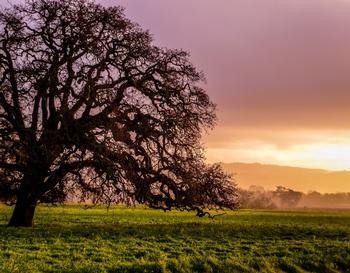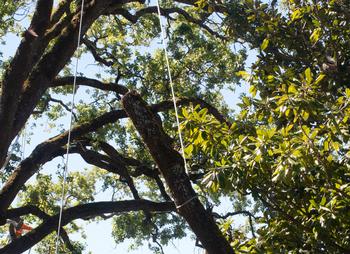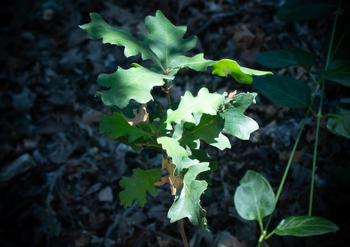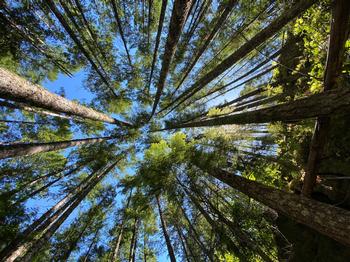Ode to a dying tree
-
Karen Gideon
-
For some gardeners, trees are members of the family. Standing, arms wide, they are the iconic background in family photos, a firm hold as kids climb and swing from their branches, and protectors sharing their canopy on a sunny day. They are the signalers of a storm coming, waving in the wind, casting a twig or limb to the ground in warning. They’re something as humble as a place to lean on a contemplative day. It’s no wonder they are subjects and characters of many of our poems, songs, paintings, and novels.
 The silhouetted gesture of a bare valley oak tree at sunrise. Photo: Karen Gideon
The silhouetted gesture of a bare valley oak tree at sunrise. Photo: Karen GideonIn the garden, trees serve as the pillars of the landscape architecture. Their presence determines who has sun and who has shade. They are a steady habitat for birds and other critters, providers of leaf litter for mulch and compost, and symbols of seasonal change as they rotate their colorful foliage through time. Because the trees sequester carbon, they are heroes in the climate crisis.
However, as trees age they may appear less splendid. We notice a wasting canopy or loss of limbs. The shape and stamina of the tree diminishes. When disease, illness or old age creeps forward, it can give the gardener pause. There’s the notion of impending loss and decisions to be made. And there might be a bit of mea culpa as the loss is occurring on our watch.
We might choose to spray or prune or give them a boost and some more time with us. But tree diseases, old age, and abiotic causes of death are difficult to reverse. Trees with weakening trunks and limbs may fall because they are unable to support their own weight when stressed with spells of heavy rain, wind, or drought. It’s time to have the tree inspected by a qualified arborist. Eventually, we may face the cost and logistics of losing a huge, heavy plant from the garden while ensuring its safe removal. It’s critical that trees are removed by experts with safety being the top concern. Heavy limbs can be dangerous to people and property. Photo: Karen
It’s critical that trees are removed by experts with safety being the top concern. Heavy limbs can be dangerous to people and property. Photo: KarenOnce the tree is gone and you’re standing on the healing scar of earth where it lived, you ask “what now?”
You may celebrate new-found sunlight, celebrating your first chance at a vegetable garden or a flower bed blooming year-round. And many gardeners may think about replacing the tree with a junior version of the tree that was lost.
While the loss may be an opportunity for a gardener who would like to make changes in their garden, remember the important role that the tree plays holistically. Plants that used to bathe in the shade of the canopy like camelias, rhododendrons, ferns and heuchera may not do well in full sun. These shade loving plants may suffer from sunburn and eventually need to be moved. Your mis-planted sun loving plants that didn’t thrive under your tree will love the sun and begin to flourish, offering you trade-offs. Consider letting an oak baby tree growing from acorns on your property continue to thrive as an eventual replacement tree. Photo: Karen Gideon
Consider letting an oak baby tree growing from acorns on your property continue to thrive as an eventual replacement tree. Photo: Karen GideonIf you’re not sure what to do, the Marin Master Gardener website offers some tools and information that help you think through some of these issues. Go to the website, http://marinmg.ucanr.edu, and click on the word BASICS on the top bar. Scroll to “Site Analysis” and click. You’ll find a set of questions that may help you decide how to approach this new phase and new area of your garden.
If you’ve decided to plant another tree in the space but are unsure of the type to select, we have relevant information on the website. On the top bar of the website, click on the word PLANTS and select “Trees and how to choose.” On this page you will find the TREE SELECTION TOOL and other information to help guide your tree decision. The spires of towering trees. From Steinbeck: “They are not like any trees we know, they are ambassadors from another time.” Photo: Catherine Wiley
The spires of towering trees. From Steinbeck: “They are not like any trees we know, they are ambassadors from another time.” Photo: Catherine WileyThere’s an old saying that the time to plant a tree was twenty-years ago. While this may be true for the gardener today, planting a tree now leaves an inspiring legacy. For future generations, your new tree will provide a climate-change hero, a critter habitat, and host of beauty.




